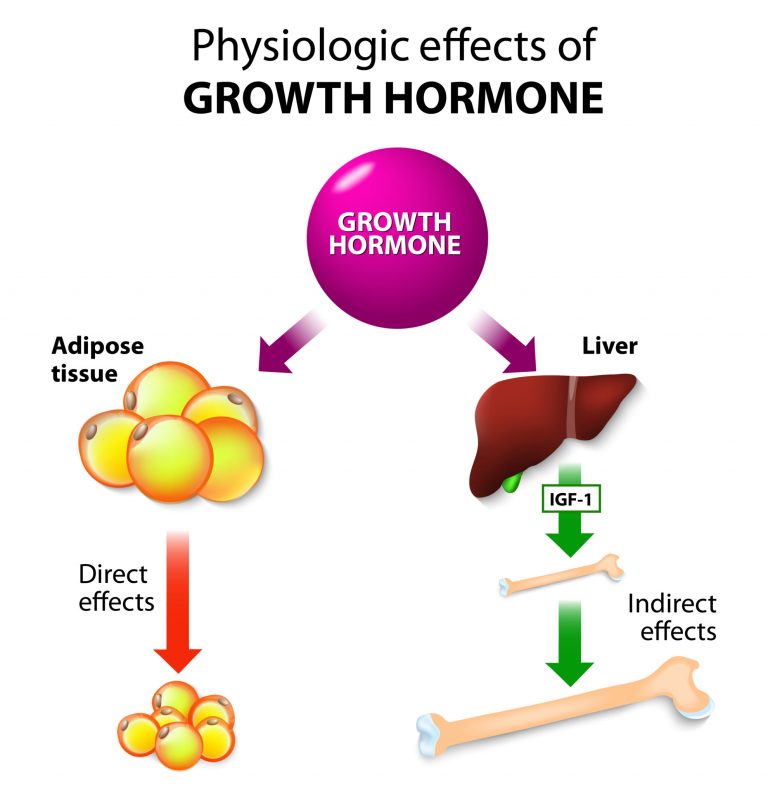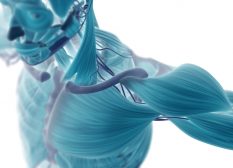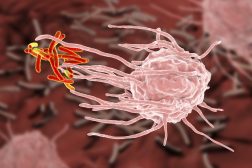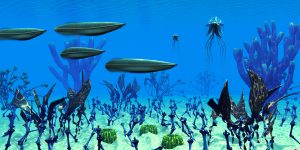Animal Growth Hormones

Direct and indirect physiologic effects of growth hormone
Table of Contents
Reviewed by: Mary Anne Clark, Ph.D.
As mentioned in the previous tutorial, hormones are produced in the endocrine glands of animals. Although some hormones are produced by direct interaction with environmental signals, many are regulated through hormones from the pituitary gland and hypothalamus. This tutorial will focus on hormones that regulate growth in animals.
Somatotropin – Growth Hormone

The pituitary gland is responsible for the production of a hormone called somatotropin. Somatotropin promotes protein synthesis throughout the body, especially in cartilage, bone, and muscle. Growth hormone is produced by the anterior pituitary under the control of the growth hormone-releasing hormone (GHRH) from the hypothalamus.
Somatotropin increases protein synthesis both by increasing the uptake of amino acids from food, decreasing the breakdown of protein, and stimulating protein synthesis. Somatotropin also stimulates the production of another growth-promoting hormone from the liver, insulin-like growth factor (IGF-1), and supports protein synthesis by increasing the fat metabolism and glucose release from the liver. IGF-1 itself stimulates growth by stimulating the reproduction of cartilage cells, which precedes bone growth, and of the myoblasts that form muscle tissue.
Somatotropin is antagonized by another hypothalamic hormone, somatostatin, which prevents the release of somatotropin from the pituitary. IGF-1 feeds back to the hypothalamus to trigger the release of somatostatin. Another hormone from the stomach, ghrelin, stimulates the release of somatotropin. Growth is therefore balanced by interactions between environmental signals, like food intake, and developmental signals from the brain.
Bones look like permanent structures, but bones are constantly remodeled even after the growth regions of bone have been closed. Bones can be remodeled in response to stresses on the bones during movement, and to repair minor stress injuries.
Thyroxine
Thyroxine, produced by the thyroid gland, is responsible for controlling the body’s metabolic rate, and therefore responsible for the amount of energy consumed and the volume of proteins produced. Normal thyroid function is necessary for growth, although it does not directly stimulate growth. The secretion of thyroxine is stimulated by thyroid-stimulating hormone (TSH) from the anterior pituitary gland, which is in turn activated by thyrotropin-releasing hormone (TRH) from the hypothalamus.
Testosterone and Estrogen
The steroid sex hormones testosterone and estrogen also have a role in regulating growth in humans. The hormone surge in adolescence produces a growth spurt in both males and females. Ironically the sex hormones both increase bone growth early in puberty and stop it later by replacing the cartilage in the growth zones with bone.
Growth Extremes
The overproduction of somatotropin can cause gigantism while underproduction can result in dwarfism. If the substance is overproduced during adulthood, the person grows overly big jaws, hands, and feet, a condition known as acromegaly.
The next tutorial investigates hormones in plants…
You will also like...

Animal Water Regulation
Animals adapt to their environment in aspects of anatomy, physiology, and behavior. This tutorial will help you understa..

Muscle
Muscle cells are specialized to generate force and movement. Learn about the different types of muscle tissues in this t..

Fruits, Flowers, and Seeds
This tutorial deals with the structure and function of flowers, fruits, and seeds. Also included here are the types of f..

Biological Cell Defense
Organisms employ different strategies to boost its defenses against antigens. Humans have an immune system to combat pat..

Running Water Freshwater Community Factors
This tutorial noted some of the physical and chemical factors that provide the framework of a running water community in..

Arthropods
The arthropods were assumed to be the first taxon of species to possess jointed limbs and exoskeleton, exhibit more adva..
